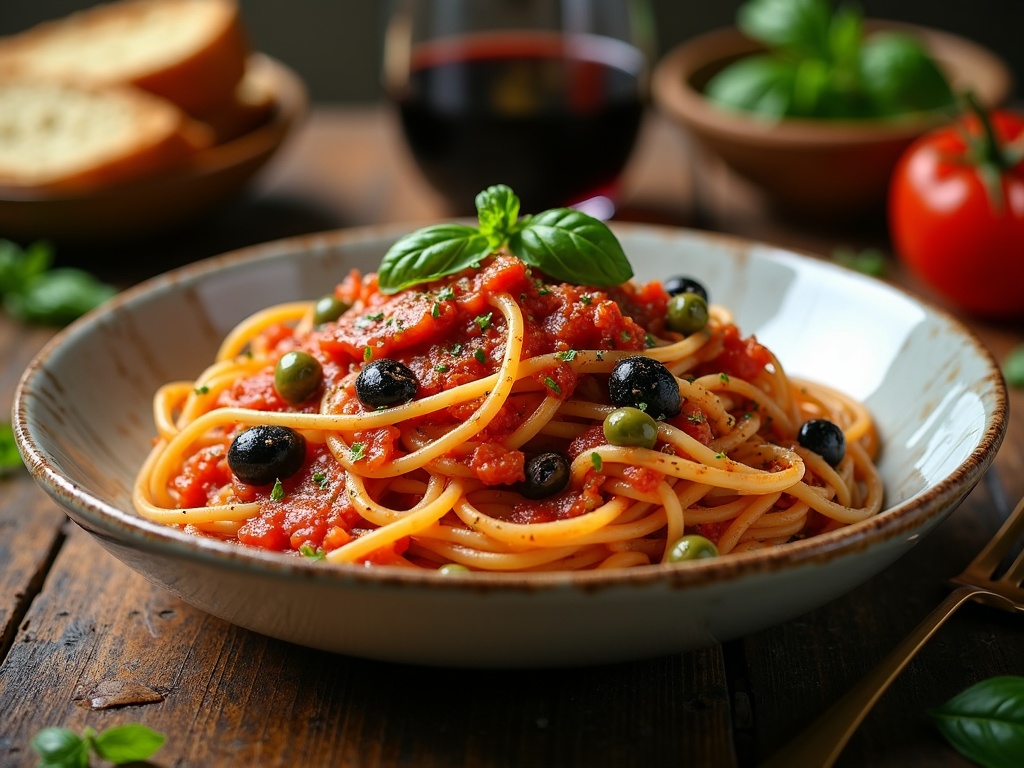Spaghetti puttanesca is a bold, flavorful Italian pasta dish that emerged in mid-20th century Naples, created from pantry essentials like olives, capers, anchovies, and tomatoes. Its name controversially translates to “whore’s spaghetti,” with stories claiming it originated as a quick meal in brothels, though it has risen above this background to become a celebrated Italian classic.
Find In This Article
Key Takeaways
- The dish can be prepared in under 20 minutes, making it perfect for weeknight meals using shelf-stable pantry ingredients.
- Traditional puttanesca embodies Southern Italian cooking philosophy with its unapologetically bold flavors and economical approach.
- The sauce’s intense flavor profile comes from the perfect balance of briny olives, salty capers, savory anchovies, and spicy red pepper flakes.
- Modern adaptations include vegetarian versions that substitute anchovies with umami-rich ingredients like soy sauce or miso paste.
- Proper plating enhances the experience—serve in warmed shallow bowls with modest portions and simple garnishes like fresh herbs or a drizzle of olive oil.
Origins in Naples’ Culinary Tradition
Spaghetti Puttanesca holds a fascinating place in Italian cuisine, particularly within the rich culinary traditions of Naples. I’ve found that this bold, flavorful pasta dish tells a story of resourcefulness and practicality that’s typical of Neapolitan cooking.
The origins of this iconic dish date back to mid-20th century Naples, though exact details remain somewhat clouded in folklore and varying accounts. What’s consistent is that puttanesca emerged from Naples’ vibrant food culture, where simple ingredients combined to create dishes with surprising depth and character.
The Birth of a Classic
The name “puttanesca” itself has sparked countless discussions about the dish’s origins. The most common theory suggests it was created in the brothels of Naples, where it could be quickly prepared between clients. Others claim it was a late-night creation for hungry customers when little else remained in the kitchen.
What makes spaghetti puttanesca distinctly Neapolitan is its use of ingredients that were readily available in the region:
- Olives (typically the small, flavorful Gaeta variety from nearby Lazio)
- Capers (often salt-packed, bringing intense briny notes)
- Garlic (abundant in southern Italian cooking)
- Anchovies (a Mediterranean staple providing savory depth)
- Tomatoes (the foundation of Neapolitan cuisine)
- Red pepper flakes (adding characteristic heat)
The magic of puttanesca lies in how these humble pantry ingredients transform into something greater than their parts. This approach reflects Naples’ culinary philosophy perfectly—creating exceptional flavor from simple, preserved ingredients that could be stored without refrigeration.
Naples in the post-WWII era faced significant economic challenges. Food scarcity demanded creativity and practicality, and puttanesca exemplifies this spirit. The dish gained popularity because it could be assembled quickly from shelf-stable ingredients, yet delivered remarkable flavor complexity.
The first documented recipe for spaghetti puttanesca appeared in cookbooks during the 1960s, though locals insist it existed in home kitchens long before. What’s notable is how little the recipe has changed over decades—a testament to its perfect balance of flavors.
Unlike many Italian dishes that vary dramatically by region, puttanesca maintains relatively consistent core ingredients despite spreading throughout Italy and beyond. This consistency speaks to the genius of its original composition in Naples.
Today, when walking through the narrow streets of Naples’ historic quarters, I still find puttanesca served in unpretentious eateries, often alongside other local classics. Its continued presence demonstrates how deeply it’s woven into the fabric of Neapolitan identity.
The story of puttanesca reminds us that Naples’ greatest culinary contributions often came from necessity rather than luxury. This city, with its dramatic history and resourceful spirit, created a dish that remains relevant and beloved worldwide while staying true to its origins.
In Naples, cooking has always been about making the most of what’s available—a philosophy that puttanesca embodies perfectly. Its bold flavors and straightforward preparation continue to represent the essence of Neapolitan cooking: unpretentious food with unforgettable character.
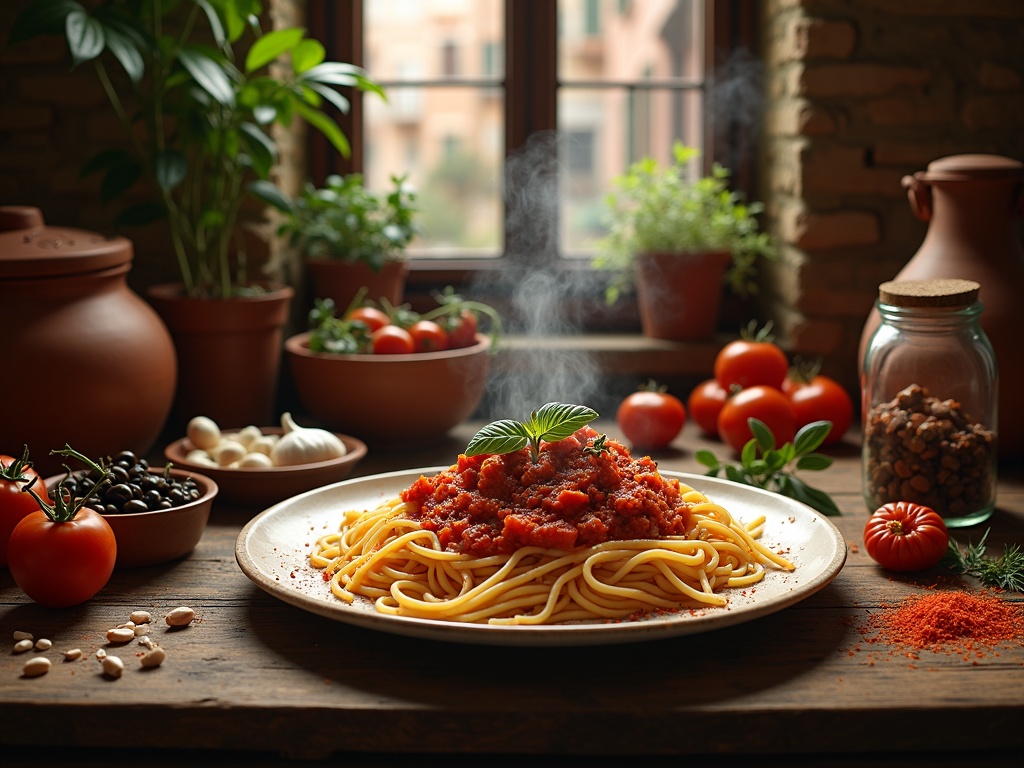
Translation of ‘Whore’s Spaghetti’ and Connection to Working Women
The name “Spaghetti alla Puttanesca” carries a colorful history that often raises eyebrows when translated literally. In Italian, “puttanesca” derives from the word “puttana,” which translates to “prostitute” in English, giving this iconic dish the somewhat provocative nickname of “whore’s spaghetti.”
The Story Behind the Name
Several theories exist about how this boldly flavored pasta dish earned its risqué name. The most common explanation connects the dish to the working women of Naples in the mid-20th century. According to local lore, these women would quickly prepare this aromatic dish between clients because:
- It could be made quickly with pantry staples like olives, capers, and anchovies
- The pungent aroma would waft through windows, potentially attracting customers
- The ingredients were inexpensive yet created a satisfying meal
I find the practicality of this origin story quite compelling. The sauce requires minimal attention and uses shelf-stable ingredients that would have been readily available in most Italian kitchens. This accessibility made it perfect for anyone needing a fast, flavorful meal without much fuss or preparation time.
Another interpretation suggests the name comes from the dish being “thrown together” with whatever was available – much like an improvised solution. The intense flavors created by combining salty anchovies, briny capers, and tangy tomatoes certainly create a bold profile that stands out.
Whether the connection to working women is historically accurate or simply culinary folklore, there’s no denying that spaghetti puttanesca has transcended its origins to become a beloved classic in Italian cuisine. Today, the dish is appreciated worldwide for its vibrant Mediterranean flavors rather than any connection to its colorful namesake.
Quick 20-Minute Preparation Time
I’ve found that spaghetti puttanesca is one of the most impressive dishes that can be made in under 20 minutes. This classic Italian pasta dish combines bold flavors that develop quickly, making it perfect for busy weeknights when I’m craving something satisfying without spending hours in the kitchen.
Simple Preparation Steps
The beauty of puttanesca lies in its straightforward cooking process. I start by bringing a large pot of salted water to boil for the pasta. While waiting for the water to boil, I prepare the sauce ingredients by mincing garlic, roughly chopping olives, and measuring out capers. The sauce itself comes together in just about the time it takes for the pasta to cook.
Once my pasta is cooking, I heat olive oil in a skillet and add garlic, red pepper flakes, and anchovy fillets (which melt into the oil creating a rich base). After about 30 seconds, I add crushed tomatoes, olives, and capers. This robust sauce only needs to simmer for 5-7 minutes to marry the flavors together perfectly.
Time-Saving Tips
To make the most of your 20 minutes, these practical tips have helped me streamline the process:
- Keep key ingredients like capers, olives, and canned tomatoes in your pantry at all times
- Use pre-minced garlic if you’re really pressed for time
- Opt for high-quality canned tomatoes which don’t need long cooking times
- Cook the sauce and pasta simultaneously to maximize efficiency
- Skip unnecessary steps like removing olive pits by purchasing pre-pitted varieties
- Have all ingredients measured and prepped before turning on the heat
The efficiency of this dish is what makes it so special. I can move from hunger to a restaurant-quality meal in less time than it takes to order delivery. For an authentic taste of this quick and flavorful pasta, you might want to check out this authentic puttanesca recipe that maintains all the traditional elements while keeping preparation time minimal.
With just a handful of pantry staples and minimal prep work, this bold, briny pasta dish proves that delicious doesn’t have to mean time-consuming.
Cultural Significance in Southern Italian Cuisine
Spaghetti Puttanesca holds a special place in the culinary heritage of Southern Italy, particularly in regions like Naples and Lazio. This dish carries with it rich stories and cultural connections that go beyond its bold flavors.
Origins and Regional Identity
The origins of Puttanesca sauce are deeply rooted in the coastal areas of Southern Italy. I’ve found that this dish represents the resourcefulness of Southern Italian cooking, where pantry staples like olives, capers, and anchovies come together to create something extraordinary. The dish embodies the Mediterranean philosophy of making delicious meals from simple, accessible ingredients.
The name itself has become legendary in Italian food lore. While various stories exist about its creation, most connect it to Naples in the mid-20th century. Some tales suggest it was a quick meal that could be prepared between clients by ladies of the night, while others claim it was simply named for its “spicy” character. Regardless of which story you believe, the dish has transcended its controversial name to become a celebrated part of Italian cuisine.
What makes Puttanesca fascinating is how it represents the bold, unapologetic flavors characteristic of Southern Italian cooking. Unlike the more subtle, cream-based sauces of Northern Italy, Southern Italian cuisine embraces intense flavors – the saltiness of capers and anchovies, the brininess of olives, and the heat of red pepper flakes all speak to the region’s culinary identity.
The sauce also tells the story of Southern Italy’s trade history, featuring ingredients that have been part of Mediterranean commerce for centuries. Capers from small islands, olives from ancient groves, and salt-preserved fish all point to the region’s historical connections to the sea and surrounding cultures.
In modern Italian culture, Spaghetti Puttanesca has evolved from its humble beginnings to become a celebrated comfort food. It’s the kind of dish that represents home cooking at its finest – quick to prepare yet deeply satisfying. While you’ll find it on restaurant menus throughout Italy and beyond, it remains a dish that many Italian families make at home when they want something flavorful without much fuss.
I’ve noticed that Puttanesca also represents the Southern Italian approach to pasta – where the sauce is intense enough that a little goes a long way, coating the pasta rather than drowning it. This economical yet flavorful approach to cooking speaks to the historical realities of Southern Italy, where resourcefulness in the kitchen was often necessary.
For travelers to Southern Italy, trying an authentic Puttanesca recipe offers a taste of the region’s culinary philosophy. Each bite delivers the sun-drenched flavors of tomatoes, the sea-kissed notes of anchovies, and the briny punch of olives and capers – all essential elements of Southern Italian flavor profiles.
Today, this dish continues to evolve while maintaining its essential character. Modern chefs might add their own touches – some might include a splash of white wine or a garnish of fresh herbs – but the core elements remain a testimony to the ingenuity and bold flavors that define Southern Italian cooking.
The cultural impact of Puttanesca extends beyond Italy’s borders, becoming a globally recognized dish that introduces people worldwide to the unapologetically bold flavors of Southern Italian cuisine. It’s a perfect example of how a regional specialty can become an ambassador for an entire culinary tradition.
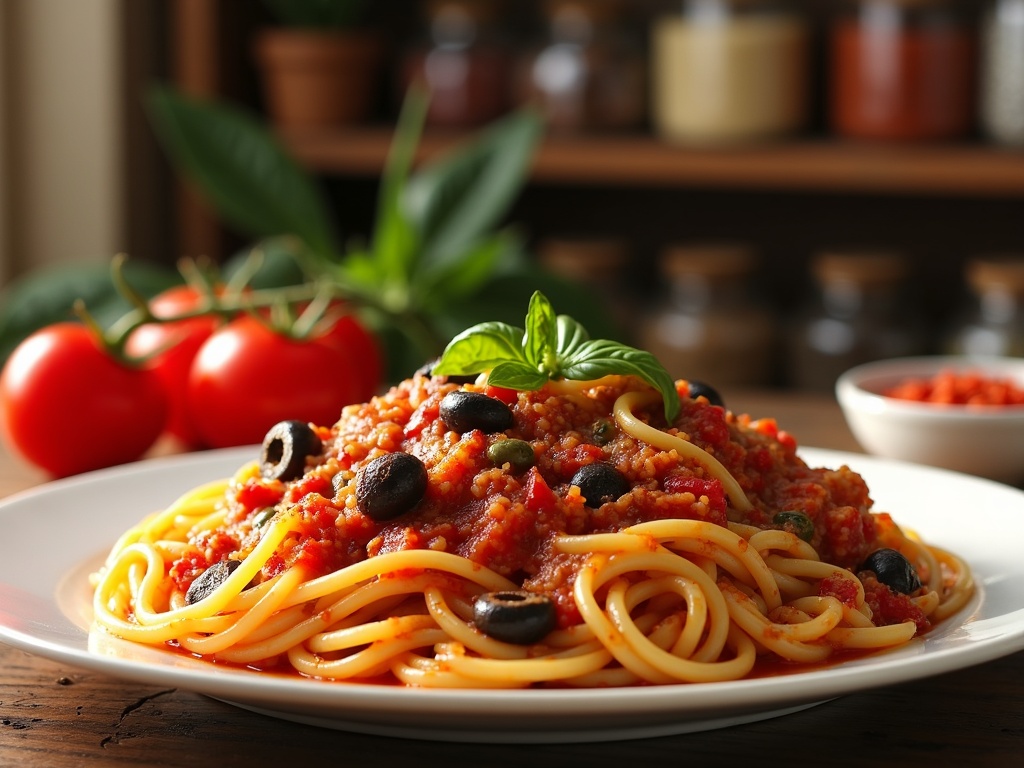
Traditional Role as an Improvisational Dish Using Available Ingredients
Spaghetti puttanesca stands as a perfect example of Italian improvisational cooking. This bold, flavorful dish emerged from necessity, created from ingredients commonly found in an Italian pantry. I’ve found that understanding this background adds depth to appreciating its rustic charm.
The Resourceful Origins
The beauty of puttanesca lies in its simplicity and accessibility. The traditional recipe revolves around shelf-stable ingredients that many Italian households would have on hand:
- Olive oil – the foundation of Mediterranean cooking
- Garlic – a staple in Italian cuisine
- Anchovies – preserved fish providing savory depth
- Olives – typically black or Kalamata for briny flavor
- Capers – adding tanginess and texture
- Tomatoes – canned work perfectly in this dish
- Dried pasta – usually spaghetti, but other shapes work too
- Red pepper flakes – for that characteristic heat
What makes this dish special is how these humble ingredients transform into something extraordinary. The combination creates a sauce that’s simultaneously salty, tangy, spicy, and rich. I’ve made this dish countless times when my refrigerator seemed empty but my pantry was stocked.
The improvisational spirit continues today. I often add whatever I have available – maybe a handful of fresh herbs if they’re around, or a splash of fish sauce when anchovies are missing. Some cooks might include a squeeze of lemon juice for brightness or throw in some canned tuna for extra protein.
This adaptability makes puttanesca especially relevant in modern cooking, where minimizing food waste and making quick meals are priorities. It’s the perfect answer to “what can I make with what I have?” – a question we all face regularly.
For a step-by-step guide to creating this classic dish with your own pantry ingredients, check out my detailed puttanesca recipe with variations and serving suggestions.
The genius of puttanesca isn’t just its flavor but its flexibility. It teaches an important cooking philosophy: sometimes the best dishes come from working with what you have rather than seeking specific ingredients. This approach to cooking encourages creativity, reduces waste, and often results in surprisingly delicious meals that become family favorites.
Essential Ingredients for Perfect Puttanesca
I’ve found that gathering all the right ingredients before starting to cook makes a huge difference when preparing spaghetti puttanesca. This bold, flavorful dish relies on a perfect balance of savory, salty, and tangy components.
The foundation of any good puttanesca starts with 400g of spaghetti, though I sometimes substitute linguine or bucatini for a different texture. For the sauce, you’ll need 400g of ripe tomatoes (canned works perfectly), 50ml of high-quality olive oil, 3 cloves of minced garlic, 6-8 anchovy fillets, 100g of pitted black olives, and 1 tablespoon of capers.
Health Benefits and Nutritional Value
Puttanesca isn’t just delicious—it’s packed with nutrients too. Each serving contains approximately 380 calories, with 10g of protein, 15g of fat, and 55g of carbohydrates.
The star ingredients offer significant health benefits:
- Black olives provide heart-healthy monounsaturated fats and antioxidants
- Capers contain quercetin and rutin, which have anti-inflammatory properties
- Anchovies deliver omega-3 fatty acids that support brain health and reduce inflammation
One of the best aspects of puttanesca is that most ingredients store well in your pantry. Olives, capers, and anchovies have long shelf lives, making this a perfect go-to meal when fresh groceries are running low.
You’ll find these ingredients readily available in most supermarkets worldwide. For the best flavor, I recommend using Kalamata olives and salt-packed capers (rinsed before using). If you’re not a fan of anchovies, you can reduce the quantity, but I wouldn’t eliminate them completely—they dissolve into the sauce and provide that distinctive umami flavor that makes puttanesca sauce so special.
The quality of your olive oil matters too. Since it forms the base of the sauce, I use a good extra virgin variety that adds its own peppery notes to the final dish.
If you have dietary restrictions, puttanesca can be adapted. Gluten-free pasta works wonderfully with this sauce, and for a vegetarian version, you can substitute anchovies with extra capers or add a splash of soy sauce for that umami kick.
Master This Classic in Under 30 Minutes
I’ve perfected my spaghetti puttanesca technique over the years, allowing me to create this robust Italian classic in under 30 minutes. The key lies in proper timing and technique, both for the pasta and the vibrant sauce.
Perfect Al Dente Pasta Every Time
Getting the pasta texture right makes all the difference in a memorable puttanesca. For perfect al dente spaghetti, I start with a large pot filled with water (about 4 quarts for 1 pound of pasta). Adding a generous tablespoon of salt to the water is non-negotiable—it’s your only chance to season the pasta itself. Once the water reaches a rolling boil, I add the spaghetti and stir immediately to prevent sticking.
For standard dried spaghetti, I cook it for 1-2 minutes less than the package instructions suggest. Testing a strand by biting through it confirms when it’s ready—it should offer slight resistance in the center but without any chalky texture. Remember to reserve about ½ cup of pasta water before draining—this starchy liquid is essential for bringing your sauce and pasta together later.
Building Bold Flavors in Minutes
The sauce comes together remarkably quickly with these steps:
- Heat 3 tablespoons of olive oil in a large skillet over medium heat.
- Add 4 minced garlic cloves and sauté for just 30 seconds until fragrant but not browned.
- Incorporate 4-6 chopped anchovy fillets, stirring until they begin to dissolve.
- Add 1 teaspoon red pepper flakes, 2 tablespoons capers, and ½ cup pitted olives.
- Pour in 1 can (14 oz) crushed tomatoes and simmer for 10 minutes.
The 10-minute simmering process is critical—it allows the flavors to meld while maintaining the sauce’s bright, bold character. During this time, I adjust seasoning with salt and pepper, though be careful with salt as the anchovies and capers already provide significant saltiness.
The timing of ingredient addition matters tremendously. Adding garlic first creates a flavor foundation, while introducing anchovies afterward allows them to melt into the oil while preserving their umami depth. This sequencing creates layers of flavor that make puttanesca distinctive.
For the perfect marriage of pasta and sauce, I add the drained pasta directly to the sauce pan along with a splash of the reserved pasta water. Tossing continuously for about a minute allows the starchy water to help the sauce cling to every strand of spaghetti, creating that restaurant-quality finish that elevates the dish. For a more authentic preparation, check out my traditional puttanesca recipe with detailed tips.
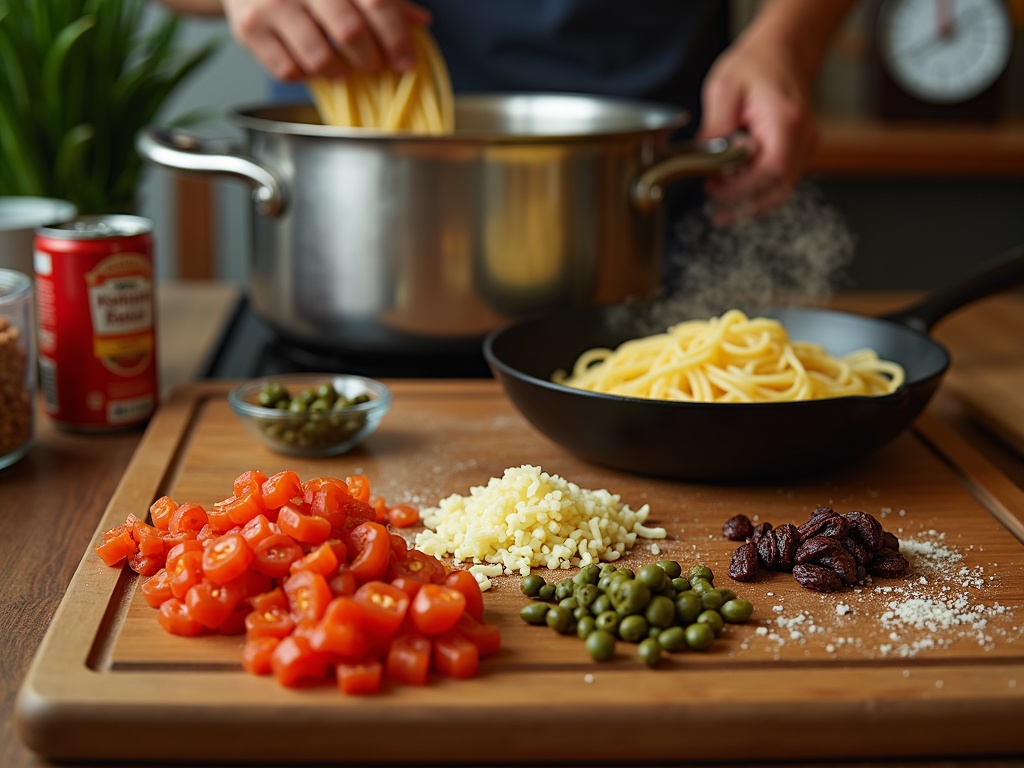
Modern Takes on Puttanesca
Traditional puttanesca sauce delivers a bold flavor punch with anchovies, but contemporary versions have adapted to suit various dietary preferences and culinary tastes.
Vegetarian Adaptations and Alternative Bases
I’ve found that creating a vegetarian puttanesca doesn’t mean sacrificing flavor. To replace anchovies, I rely on capers and olives to provide that briny, savory element. Adding a splash of soy sauce or miso paste contributes umami depth that mimics the anchovy flavor profile. For an extra boost, nutritional yeast adds cheesy notes without dairy.
Alternative pasta bases have transformed how we enjoy this classic dish. Whole wheat pasta offers a nutty flavor and higher fiber content. Gluten-free options like chickpea pasta, rice noodles, or spiralized zucchini “zoodles” make puttanesca accessible to everyone. Each alternative brings its own texture and nutritional benefits to the table.
Creative Additions and Pairings
Protein additions can turn puttanesca into a heartier meal. Grilled chicken brings a mild flavor that balances the sauce’s boldness. Shrimp cooks quickly and complements the Mediterranean flavor profile perfectly. For plant-based options, chickpeas or white beans blend seamlessly into the sauce.
The heat level in puttanesca is customizable through various spice elements:
- Red pepper flakes provide traditional heat
- Fresh chilies add bright spiciness and color
- Smoked paprika contributes depth without overwhelming heat
- Harissa paste introduces North African flair
When serving puttanesca, I pair it with simple side dishes that don’t compete with its robust flavors. A crisp green salad with lemon vinaigrette offers refreshing contrast. Garlic bread provides a perfect vehicle for soaking up extra sauce. For a complete Italian experience, start with a light antipasto platter featuring marinated vegetables.
The beauty of modern puttanesca lies in its adaptability while maintaining its spirit of bold simplicity. Whether you’re looking for a quick weeknight dinner or an impressive yet easy entertaining option, a contemporary take on spaghetti puttanesca delivers satisfaction without complexity.
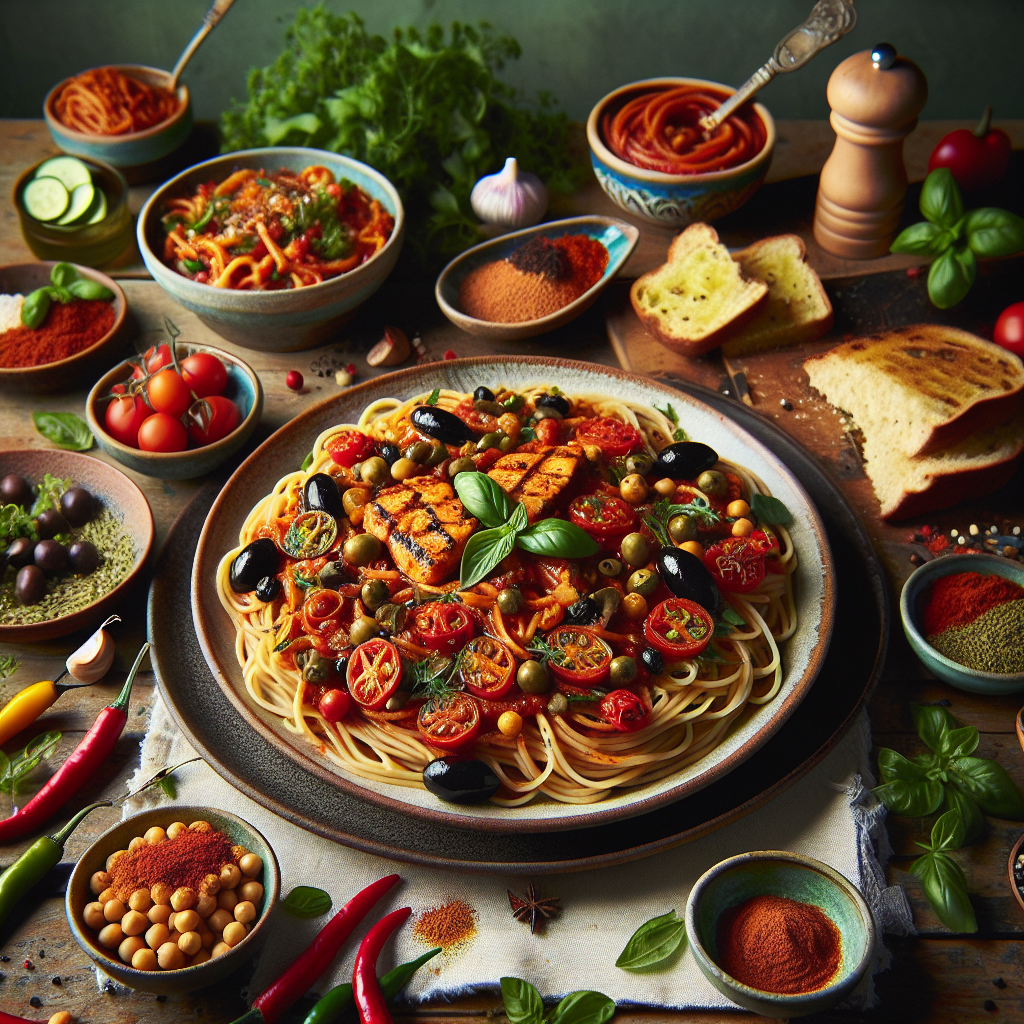
The Perfect Puttanesca Plate
Plating spaghetti puttanesca isn’t just about dumping pasta on a dish—it’s about creating a memorable dining experience. I’ve found that traditional Italian serving methods enhance both the visual appeal and flavor of this robust dish.
Traditional Serving Approaches
Italians typically serve puttanesca in warmed, shallow pasta bowls that allow the sauce to spread evenly without pooling at the bottom. I recommend using tongs to create a neat spiral of pasta, forming a small mound in the center of the plate. This technique ensures every bite contains the perfect balance of pasta and that intensely flavorful sauce with olives, capers, and anchovies.
Portion sizes should remain modest—about 2-3 ounces of dried pasta per person as an appetizer or 4-5 ounces for a main course. This classic dish is quite filling due to its bold flavors, so smaller portions often satisfy just as well as larger ones.
For an authentic touch, pair your puttanesca with crusty Italian bread to soak up any remaining sauce. A small side of bitter greens dressed simply with olive oil and lemon juice offers a refreshing contrast to the sauce’s intensity.
Elevating Your Presentation
Garnishing brings your puttanesca to life visually and adds fresh flavor dimensions. Consider these finishing touches to enhance your dish:
- Fresh basil leaves, torn rather than chopped to preserve their aroma and prevent browning
- A light sprinkle of finely chopped parsley for color contrast
- Grated Pecorino Romano cheese (use sparingly as the sauce is already quite salty)
- A light drizzle of high-quality extra virgin olive oil
- Freshly cracked black pepper
The wine you choose can make or break your puttanesca experience. The dish’s bold, briny flavor profile pairs beautifully with acidic red wines that can stand up to the intense sauce. A young Sangiovese or Chianti Classico works wonderfully, cutting through the richness while complementing the tomato base. For white wine enthusiasts, a crisp, mineral-forward Vermentino from Sardinia offers a refreshing counterpoint.
I always serve puttanesca immediately after plating—the heat helps release the aromas of the herbs and sauce. This simple yet sophisticated dish doesn’t need elaborate presentation techniques, just thoughtful attention to temperature, portion size, and fresh garnishes to showcase its rustic charm.
Sources:
The History of Italian Cuisine: Recipes, Ingredients and Traditions by Maria Giulia Marini
Nutrition and Health Benefits of Anchovies from Food and Nutrition Journal
Pasta Puttanesca: A Simple Italian Recipe for Busy Lives from Italian Cooking magazine
Culinary Traditions of Southern Italy by Francesco D’Auria

